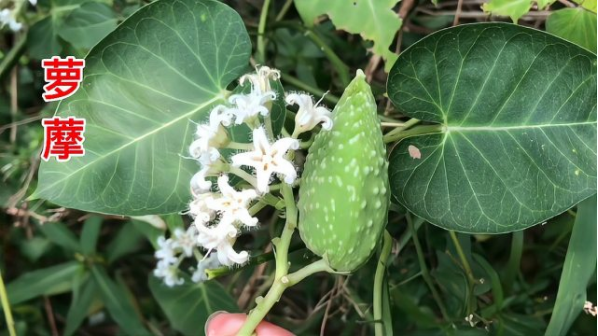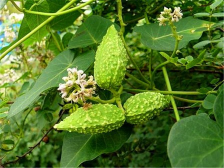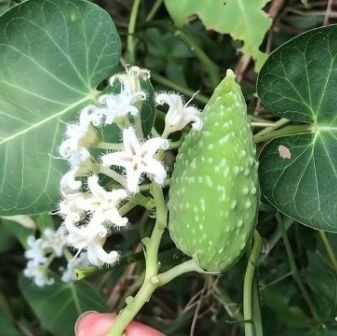Luobuma (Euphorbia lathyris), belonging to the Apocynaceae (Dogbane family) and Gynostemma (a genus of climbing plants), is a perennial herbaceous vine with tuberous roots, and the entire plant contains latex. The leaves are opposite, ovate to heart-shaped, tapering to a point, and glabrous. The corolla is white with pinkish internal grooves and soft hairs.

Luobuma is distributed in Japan, Korea, Russia, and China; in China, it is found in the Northeast, North China, East China, and provinces such as Gansu, Shaanxi, Guizhou, Henan, and Hubei. It grows in forest edges, wastelands, at the foot of mountains, by rivers, and in roadside shrubs.
According to the “Shandong Economic Plants,” “The root is used in medicine. It can detoxify and treat bone and joint tuberculosis; the hairs on the seeds have hemostatic effects. Locally, the whole plant is used to treat bronchitis.” Moreover, Luobuma is a commonly used herb in Guizhou, utilized by the Han, Miao, Dong, and Bouyei ethnic groups. The medicinal materials are all sourced from the wild. Luobuma is often planted in gardens, serving as an excellent vertical greening material for low walls, flower corridors, and fences, with its stem fibers being strong enough to produce artificial cotton materials.

Luobuma was historically known as Walan, mentioned in the “Book of Songs.” In the earliest pharmacopoeia, the “Shennong Bencao Jing,” there is no early record of Luobuma, but it is included in the section on high-quality herbs with Gouqi (Lycium barbarum). Tao Hongjing supplemented the folk sayings of the time: “If you are a thousand miles from home, do not eat Luobuma or Gouqi.” Tao Hongjing also stated: “Luobuma, known as bitter Walan, has thick large leaves, grows as a vine, and causes swelling. People in the East call it white ring vine, growing between fences, and when picked, it exudes white latex; it is also called ‘sparrow gourd,’ and many households cultivate it…” This is the earliest description of the morphology and ecology of Luobuma.
The seeds of Luobuma are arranged around a central axis inside the fruit, and when the fruit splits open, it resembles a compressed spring releasing, with the expanded silky hairs carrying the small seeds “surging” out of the fruit shell, carried away by the wind.
Life form: perennial herbaceous vine.
Height: up to 8 meters, with latex.
Leaves: membranous, ovate to heart-shaped, 5-12 cm long, 4-7 cm wide, with a short tapering tip, heart-shaped base, rounded leaf ears, 1-2 cm long, with the two leaf ears either spreading or closely adjacent. The leaf surface is green, and the underside is pale green, glabrous or slightly hairy when young, becoming glabrous as it matures; there are 10-12 lateral veins on each side, slightly prominent on the underside; the petiole is long, 3-6 cm, with clustered glands at the tip.
Flowers: arranged in a racemose corymb that is axillary or extra-axillary, with long peduncles; the peduncle is 6-12 cm long, covered with short soft hairs; the flower stalk is 8 mm long, also covered with short soft hairs, usually with 13-15 flowers; the small bracts are membranous, lanceolate, 3 mm long, with a tapering tip; the flower buds are conical with a pointed tip; the calyx lobes are lanceolate, 5-7 mm long, 2 mm wide, with fine hairs on the outside; the corolla is white with pale purple-red markings, nearly radially symmetrical, with a short corolla tube, the corolla lobes are lanceolate, spreading, with the tips reflexed, and the base overlapping to the left, with soft hairs on the inside; the corona is ring-shaped, attached to the fused corolla, with 5 lobes, the lobes are cup-shaped; the stamens are fused into a conical shape surrounding the pistil, with the anthers having white membranous tips; the pollen grains are oval and drooping; the ovary is glabrous, and the style extends into a long beak, with a bifid tip.
Fruit: a capsule that is spindle-shaped, smooth and glabrous, 8-9 cm long, 2 cm in diameter, with a sharply pointed tip and a swollen base; the seeds are flat, oval, 5 mm long, 3 mm wide, with a membranous margin, brown, with white silky hairs at the tip; the hairs are 1.5 cm long.
Phenology: flowering from June to September, fruiting from September to December.
Cultivation: It has strong adaptability to soil. If conditions allow, it is best to choose well-drained, humus-rich loam. Luobuma is usually planted in March-April using direct seeding. It should be planted in a high, open, sunny location, avoiding windy areas. For ease of future operations, it is best to set up supports oriented east-west. Then, next to it, maintain a spacing of 40 cm and dig holes with a diameter of about 30 cm and a depth of about 30 cm. Typically, water the holes thoroughly before sowing 6-10 seeds, then cover with 1.2 cm of fine soil. After the seedlings emerge, keep one plant per hole and remove the rest.
Management: In the early growth stage, Luobuma should have controlled watering to promote root development. During the hot summer and autumn, timely watering is necessary for the plants to produce lush leaves. It is drought-resistant, and no base fertilizer is needed for good growth at planting; during summer and autumn, fertilization can be done every 2-3 weeks. During cultivation, ensure that the plants receive at least 4 hours of direct sunlight daily. They grow well in temperatures between 16-30°C. After winter, the above-ground parts of the plant die back, and at this time, they can be cut back and buried deeply. Under good management conditions, Luobuma is not prone to diseases and rarely suffers from harmful animals. When the fruits are mature but not yet split, they should be harvested, dried, and the seeds extracted and cleaned, storing the seeds in a dry, well-ventilated place away from light. This plant is perennial and grows quickly from propagation to maturity. If there are signs of continuous weakening of plant growth or smaller leaves, consider renewing the plants.
Medicinal Value: According to the “Shandong Economic Plants,” “The root is used in medicine. It can detoxify and treat bone and joint tuberculosis; the hairs on the seeds have hemostatic effects. Locally, the whole plant is used to treat bronchitis.” Moreover, Luobuma is a commonly used herb in Guizhou, utilized by the Han, Miao, Dong, and Bouyei ethnic groups. The medicinal materials are all sourced from the wild. The entire plant is medicinal: the fruit can treat labor injuries, weakness, back and leg pain, insufficient milk, leukorrhea, and cough; the root can treat bruises, snake bites, carbuncles, and impotence; the stems and leaves can treat childhood malnutrition and carbuncles; the seed hairs can stop bleeding; the latex can remove warts.
Economic and Ornamental Value: The stem fibers are strong and can be used to make artificial cotton. This plant is often used in gardens, serving as excellent vertical greening material for low walls, flower corridors, and fences, with its stem fibers being strong enough to produce artificial cotton materials.
Source: InternetNote: This article is for educational exchange only, copyright belongs to the original author and source. If there are any copyright issues, please contact us for timely handling. It does not provide medical guidance or medication advice, and is for reference only.

